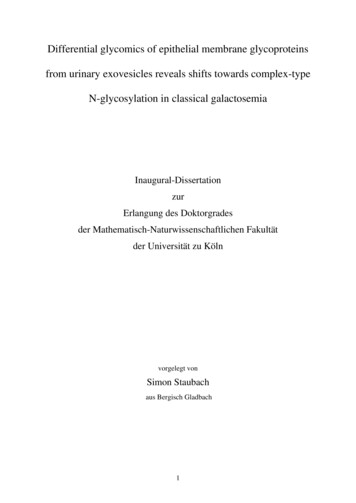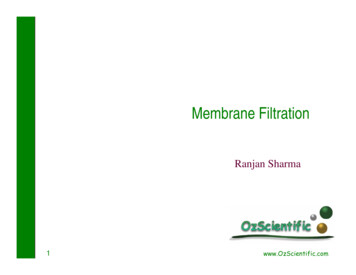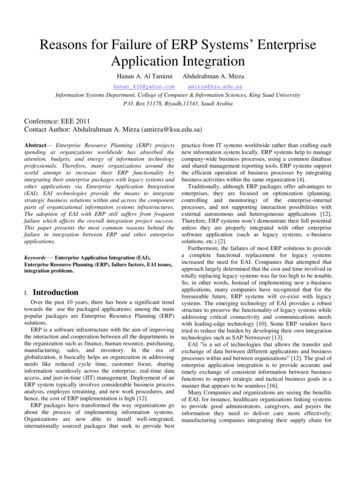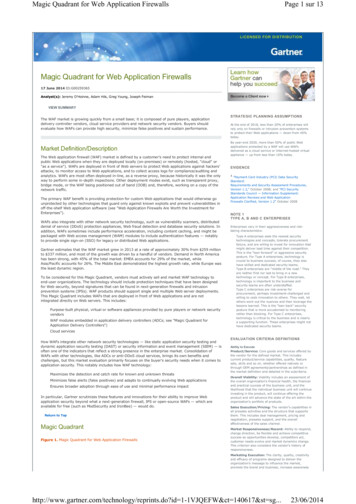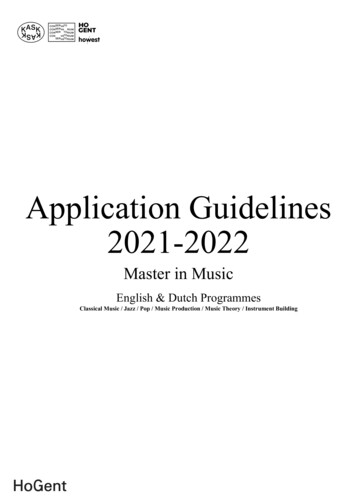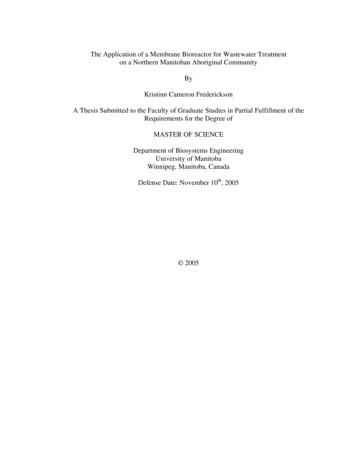
Transcription
The Application of a Membrane Bioreactor for Wastewater Treatmenton a Northern Manitoban Aboriginal CommunityByKristinn Cameron FredericksonA Thesis Submitted to the Faculty of Graduate Studies in Partial Fulfillment of theRequirements for the Degree ofMASTER OF SCIENCEDepartment of Biosystems EngineeringUniversity of ManitobaWinnipeg, Manitoba, CanadaDefense Date: November 10th, 2005 2005
ABSTRACTWater infrastructure on Aboriginal communities in Canada, and specifically NorthernManitoba is in sub-standard condition. A recent Government of Canada study indicatedthat an estimated 1.5 billion would need to be spent to improve this infrastructure.September 2003 through July 2004, an examination of the effectiveness of a membranebioreactor (MBR) in a Northern Manitoban Aboriginal community took place. Thisstudy was intended to identify and test an appropriate and effective solution for the lackof adequate wastewater treatment in these communities. The MBR system, employing aZenon ZW-10 ultrafiltration membrane, was designed and constructed at the Universityof Manitoba. It was installed and tested in two phases at the Opaskwayak Cree NationReserve in Northern Manitoba.Phase I was a direct comparison between the pilot-scale MBR and the community’sexisting Sequencing Batch Reactor (SBR) with sand filter. This phase occurred fromSeptember 2003 until December 2003. The MBR, with an SRT of 20-days and an HRTof 10 hours, outperformed the SBR in every category despite 2 mechanical/electricalfailures that resulted in the loss of biomass from the MBR. The SBR/Sand filtercombination had BOD, TSS, and TKN concentrations of 30.3 mg/L, 27.5 mg/L, and 8.4mg/L, respectively. By comparison, the BOD, TSS, and TKN concentrations in the MBReffluent were 6 mg/L, 5 mg/L, and 1.3 mg/L respectively.I
Phase II, from March 2004 through July 2004, tested the overall MBR efficacy andintended to assess a novel remote control and monitoring system. The MBR SRT wasadjusted to 40-days and, as expected, the MBR MLVSS concentration increased to arelatively stable 5000 mg/L. The MBR continued to provide high quality effluent withsome exceptions. Despite the 0.034 µm pore size, the total coliforms and TSS measuredin the effluent were higher than in Phase I. This indicates a compromised membrane,faulty sampling procedures, or biological regrowth downstream of the membrane. Thisfailure could point to the need for some form of tertiary disinfection.Also in Phase II, a remote control and monitoring program was implemented. Thecontrolling PC was controlled via the internet using pcAnywhere software. The softwareallowed for real-time monitoring and complete control of the pilot system.In conclusion, the pilot-scale MBR yielded consistent, high quality wastewater effluentand this would benefit the pristine environments existing in Manitoba’s north. Thepotential hands-free operation could be utilized to provide support to communitieslacking sufficient wastewater treatment know-how.II
ACKNOWLEDGEMENTSThere are a great many people that require my deepest, heart-felt thanks. This projectcould not have been finished without their support and understanding. First and foremostI need to thank my family for providing a roof over my head in more than the physicalsense. They have been, and will continue to be, the foundation for over-coming everychallenge I have ever faced. I am sincerely grateful to Dr. Nazim Cicek, my thesisadvisor, for his wisdom, expertise, and, most importantly, his Herculean patience, which Iknow I’ve tested throughout the course of the project. My committee members, Dr. JanOleszkiewicz, Dr. Beata Gorczyca and Randy Herrmann deserve my appreciation fortheir patience and help with this project. I must thank the community of OpaskwayakCree Nation and hosts, Dan and Maria Moore for their warmth and kindness while I livedin their home. This project also would not have been a success without Harold Youngand John Mackenzie, the OCN Water and Wastewater Plant Operators. I mustacknowledge the Biosystems tech team including Dale Bourns, Matt McDonald, andJerry Woods as well as Ms. Judy Tingley from the Environmental Lab for theirinstrumental role in developing, implementing and testing the pilot-system. I need toacknowledge Manitoba Hydro Corp and Zenon Environmental for their generous supportfor the project. I also need to recognize the Biosystems Faculty members including Ms.Connie Wenzoski and Debby Watson for their support throughout my undergrad andgraduate degrees. Last, but certainly not least, I need to thank my partner, SaraWilliscroft, for her love, devotion, and words of motivation over the past three years.III
TABLE OF CONTENTSABSTRACT. IACKNOWLEDGEMENTS. IIITABLE OF CONTENTS. IVLIST OF FIGURES . VILIST OF TABLES. VIII1INTRODUCTION . 12LITERATURE REVIEW . 22.1First Nations Health . 22.2National First Nations Wastewater Treatment Assessment. 32.3Manitoban First Nations Communities. 62.4Manitoban Assessment of First Nations Wastewater Treatment. 72.5Roles and Responsibilities of INAC and First Nations . 112.5.1Indian Northern Affairs Canada. 112.5.2First Nations. 122.6Current Wastewater Effluent Guidelines . 142.7Future Wastewater Effluent Guidelines. 142.8Wastewater Treatment Systems. 152.8.1Sequencing Batch Reactors. 152.8.2Rotating Biological Contactors. 172.8.3Extended Aeration . 172.8.4Facultative Lagoons . 182.8.5Membrane Bioreactors. 193 RESEARCH OBJECTIVES . 354 MATERIALS AND METHODS. 374.1Site Selection . 374.2Demographics of OCN . 394.3Sequencing Batch Reactor . 394.4MBR Design . 424.5Instrumentation . 504.6Automated Control. 524.6.1Visual Basic Program . 524.6.2Remote Control and Monitoring. 554.7Sampling and Operation Methodology. 574.7.1Data Collection and Analysis. 575RESULTS . 605.1Pilot System Drawbacks . 605.2MBR vs. SBR (Sep 03 - Dec 03) . 695.3MBR Efficacy (March 2004 - July 2004) . 805.3.1Mixed Liquor . 815.3.2Effluent Quality . 816 CONCLUSIONS. 92IV
7Recommendations for OCN Wastewater Treatment . 947.1Repair or Decommission Sand Filters . 957.2Repair Ultraviolet Light Disinfection . 957.3Retrofit a Full-Scale MBR in Second SBR Reaction Vessel. 968Engineering Significance and Future Work. 96REFERENCES . 98APPENDIX. 101V
LIST OF FIGURESFigure 1: Enteric food and waterborne diseases among children aged 0 to 14, in FirstNations versus Canada in 2003 (Health Canada, 2003). . 4Figure 2: Sequence of wastewater treatment in a typical SBR. 16Figure 3: Submerged MBR Configuration - the membrane is situated inside the reactionvessel. 22Figure 4: External MBR Configuration: In both of the above iterations of the externalMBR, the membrane is placed outside of the main reaction vessel. . 22Figure 5: An example of Zenon Zeeweed Cassette . 25Figure 6: Location of the Opaskwayak Cree Nation and pilot-scale MBR. . 38Figure 7: Location of the MBR within the existing plant. 41Figure 8: Pilot-scale membrane bioreactor (Left). 44Figure 9: Pilot-scale membrane bioreactor (Rear). 45Figure 10: Pilot-scale membrane bioreactor (Front). 46Figure 11: MBR Pilot System (left side) . 47Figure 12: MBR Pilot System (right side) . 48Figure 13: Pilot MBR (front) . 49Figure 14: Pilot System Configuration . 51Figure 15: Algorithm for MBR sludge removal program. 53Figure 16: Algorithm for micro-pump operation. 54Figure 17: Screenshot from remote computer while controlling pilot system. 56Figure 18: Plugged screen on foot valve. 62Figure 19: Guard screen for foot valve . 63Figure 20: Reflective Insulation for Feed Water Piping. 64Figure 21: Heat tracing for feed water piping. 65Figure 22: Heat tracing on raw wastewater cap. 66Figure 23: Membrane with mold growth. Transport packaging in back . 67Figure 24: Torn and moldy membrane . 68Figure 25: From left to right: Tap Water, MBR Effluent, SBR Filter Effluent. 73Figure 26: Increase in transmembrane pressure between two chemical cleaning events . 74Figure 27: Mixed liquor volatile suspended solids concentrations in both the SBR andMBR. 76Figure 28: Effluent BOD comparison between MBR, SBR Filters, and raw wastewater78Figure 29: Effluent suspended solids comparison between MBR, SBR Filters, and rawwastewater. 79Figure 30: MBR Mixed Liquor Total and Volatile Solids concentrations from Marchthrough July 2004 . 84Figure 31: MBR Mixed Liquor Suspended Solids concentration from April through July2004. 85Figure 32: MBR Effluent Chemical Oxygen Demand from March through July 2004 . 86Figure 33: MBR Mixed Liquor Soluble COD from April through July 2004. 87Figure 34: MBR Effluent Ammonia, Nitrate, and Total Nitrogen from March throughJuly 2004. 88Figure 35: MBR Mixed Liquor Total Nitrogen concentrations from March through July2004. 89VI
Figure 36: MBR Effluent Total Phosphorous concentrations from March through July2004. 90Figure 37: MBR Effluent Biochemical Oxygen Demand and Total Coliforms levels fromMay through July 2004 . 91VII
LIST OF TABLESTable 1: Assessment of Water and Wastewater Treatment Systems in First Nationscommunities (INAC, 2003). . 5Table 2: Wastewater Treatment Systems in Manitoban First Nations Communities(INAC, 2004). . 8Table 3: Common problems associated with the 3 categories (INAC, 2004) . 10Table 4: First Nations Water Management Strategy (adapted from INAC, 2004). 13Table 5: Comparison of the federal and provincial guidelines for wastewater effluentdisposal . 14Table 6: OCN Sequencing Batch Reactor operational parameters. 40Table 7: Testing Matrix for Pilot Testing . 58Table 8: Drawbacks of the pilot-system and potential mitigation measures . 61Table 9: Opaskwayak Cree Nation raw wastewater characteristics . 70Table 10: Comparison of effluent characteristics . 72Table 11: MBR Analysis for Mixed liquor and Effluent. 83VIII
1 INTRODUCTIONFirst Nation’s communities in Canada are experiencing severe water and wastewaterinfrastructure problems.A federal report indicated that approximately 60% of allwastewater treatment systems were ranked either medium or high risk for failure andrequired immediate attention (INAC, 2003). Drinking and wastewater treatment fallsunder the jurisdiction of the local band government with capital costs covered by Indianand Northern Affairs Canada (INAC, 2004). It was estimated that approximately 1.6billion would be required to address the wastewater treatment deficiencies.Although unclear in the federal report, Manitoban First Nations wastewater systems werenot better off than the national average. In a previous study, it was discovered that about75% of wastewater treatment systems on Manitoba’s First Nations communities weresubstandard (Frederickson, 2002). More alarming is that 35% of those systems posed animmediate environmental and/or health risk. Such problems exist with a wide range ofwastewater treatment systems; from septic fields to sequencing batch reactors.Forexample, on some First Nations communities, leaky septic tanks and improperly designedseptic fields contaminated drinking water cisterns used for public consumption.Sequencing batch reactors with effluent contaminant levels well above the federalenvironmental limits were found placed upstream of drinking water intakes.Thecommunities were plagued with broken valves, leaky sewage pipes, old equipment, andpoorly designed and overly complex systems. Lack of operator training and attention1
coupled with deficient equipment currently pose a crisis in wastewater treatment on manyManitoban reserves.This study was undertaken to explore the effectiveness of membrane bioreactors (MBR)in addressing the unique suite of problems encountered on many of Canada’s FirstNations communities.The following sections outline the problems, the currentwastewater treatment systems in place on Manitoban reserves, and the operation of apilot-scale MBR on the Opaskwayak Cree Nation. This thesis is both a way to raiseawareness on the infrastructure deficit experienced in Canada’s Aboriginal populationand to explore the novel technology of membrane bioreactors.2 LITERATURE REVIEW2.1 First Nations HealthFood and waterborne illnesses have a higher rate of incidence in the First Nationspopulation relative to the Canadian population (Health Canada, 2003). The rates amongFirst Nations’ children under the age of 15 are appallingly high.For example,shigellosis, a gastrointestinal disease related with poor water treatment, occurs over 22times more frequently in First Nations children. Figure 1 outlines the rate of incidence offood and waterborne illnesses. These unacceptable statistics prompted an INAC study onwater and wastewater systems in First Nations communities.2
2.2 National First Nations Wastewater Treatment AssessmentIn 2003, INAC released a report entitled “National Assessment of Water and WastewaterSystems in First Nations Communities”.The INAC study had several objectivesincluding an assessment of on-reserve systems, identification of deficiencies, andrecommendation for improvements. Local regions contracted the study to engineeringfirms. The study had some limitations; notably that all water samples were based ondatabases owned by Health Canada and INAC. Furthermore, the study was limited tolarger systems and:“Individual systems and thos
bioreactor (MBR) in a Northern Manitoban Aboriginal community took place. This study was intended to identify and test an appropriate and effective solution for the lack
